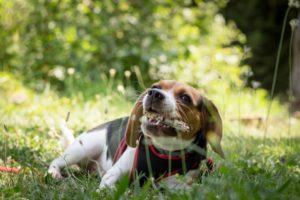
Is your puppy eating everything in sight? Here’s why it might be happening and what to do about it.
A puppy wants to explore the world, and with such acute smelling abilities (10,000 times better than ours,) what better way to find out what things are than by putting those objects in their mouths? While the rare chew on some grass or a stick might be harmless, it is always a problem when puppies and adult dogs chew or consume whatever non-edible item in sight. Most puppies grow out of the habit, but sometimes it can continue into adulthood. To help keep your dog from eating everything it sees, here is a brief explanation of the causes, the signs your dog has eaten something it shouldn’t, and what to do about it.
Causes
Pica is the name for when a dog keeps eating non-food items. It is an almost obsessive, irresistible urge. Your dog may be eating anything: grass, dirt, rocks, socks, underwear, pillows, poop, used diapers, used feminine products, carrion, and more are all on the list. The eating of feces is called coprophagia. This is the type of eating that usually wears off over time.
Boredom or loneliness is another main cause. Just as people might have a late-night snack for fun, your dog might nibble on some object for pleasure as well.
A third reason is that your dog by nature just tends to be hungry all the time.
Signs
While eating such non-edible things may be problematic and disgusting, such objects may cause internal bleeding, infection, disease, and more if swallowed. The most obvious signs are diarrhea and vomiting. Other signs include loss of appetite, lethargy, pain in the abdomen, and change in behavior.
What to Do
If your dog has ingested an object that may make him or her ill, take your pet to the vet or call to see if there’s a risk of a serious problem. Sometimes eating foreign objects can be a sign of a more serious issue. You may also want to check that the foreign object has passed through the dog’s system and is not lodged inside the digestive system. Simply take a stick and poke around for the object in your dog’s stool.
Once you are sure that your dog’s health is not in jeopardy, take preventative measures, such as puppy-proofing the house and removing the source of the attraction if possible.
Training will be your biggest step in prevention. While each dog may have different needs to address, basic training is to teach your dog to obey your command, like “No” and “Drop it” regarding food, whether edible or non-edible, on the ground. Keep it fun, and reward your dog with a delicious and nutritious doggy treat when he or she does what’s right.
Trust the Care of Your Pet to the Professionals at Everhart Veterinary Medicine!
At Everhart Veterinary Medicine, our veterinary professionals strive to provide your pet with the very best of veterinary care. We believe that the best care for your pet should be provided by experienced, compassionate, and knowledgeable veterinary professionals. With two Maryland locations in both Baltimore and Pasadena, we are always ready to welcome your pet as a new patient! Give us a call today at 410-355-3131 or 410-793-7670! For more information, as well as updates on veterinary news and topics, visit us on Facebook, Twitter, LinkedIn, or Pinterest!
